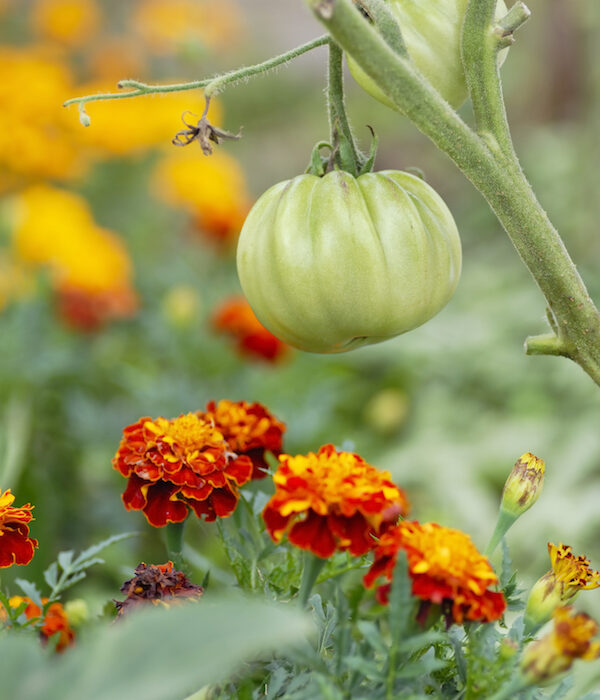
Companion planting helps fight pests in your garden. For example, marigolds protect tomatoes from aphids, giving the fruit a chance to ripen to perfection.
As a gardener, you might feel a bit defeated when every time you check your vegetables and flowers, something has taken a big bite out of them. Destroying garden pests isn’t the only way to fight them. Here are a few tips to help keep the threats to your hard work in the garden under control:
1. Identify the culprits, then get rid of them
While you might want to rush out and coat your garden with insecticides at the first sign of trouble, you need to slow down, take a breath and find out what’s going on. The first step to controlling any pest is identifying the particular insect or pest. Then, you can start formulating a plan.
• Fire ants are the scourge of many Coastal Bend yards. When you find a mound, pour three gallons of boiling water over it, which kills about 60 percent of the ants. Also consider using bait poisons vs. contact ones. If possible, get the neighborhood involved so everyone treats at the same time. That keeps the ants from moving from a treated yard to an untreated one.
• Aphids attack just about everything in your garden. If you sit still long enough, there’s a good chance they’ll move in on you. One of the most effective ways to rid plants of these creatures is by washing the plants with a strong water spray. Applying garlic repellent sprays can help deter the creatures as well.
• Cutworms make tomato growers red with rage. You’ll go to bed one night and your tomatoes seedlings are great, but when you walk out in the morning, several are lying on the ground. It looks as if somebody went through with dull scissors and cut them down. The culprit is most likely cutworms. Prevention is essential and includes destroying the worms and larva (which are in the soil) by turning over the dirt during the summer and winter.
Sprinkle a little diatomaceous earth around the seedlings and work it in a bit to further deter these destructive pests. Another option is scattering the bacteria Bt (Bacillus thuringiensis). Spread a cutworm bait made by mixing Bacillus thuringiensis var. kurstaki with moist bran and molasses over the surface of the garden soil.
• Caterpillars of all types see your garden as a giant salad buffet. These slow-moving creatures gobble up your plants’ leaves in an instant. Your best defense is encouraging native predators such as birds and certain wasps. You can hand pick them off plants or spray with Bacillus thuringiensis (Bt). • Don’t let beetles beat you. The two beetles you’re most likely to see are the flea beetle and the cucumber beetle.
But before you rush out and spray at the first sign of a beetle, make sure it’s an adversarial one. Many beetles, such as ladybugs, are beneficial as they feed on caterpillars, aphids and other pests. Some ways of defeating the bad beetles include selecting disease-resistant plants, running your vine-growing vegetables on a trellis to keep them off the ground and treating the soil with beneficial nematodes.
2. Encourage natural predators and beneficial insects
Don’t lump all insects into the bad category. Some are a gardener’s best friend. Insects such as ladybugs, praying mantis and predatory mites help control the bad insects. Learn about your friends and ways to entice them to your garden.
3. Practice companion planting
Companion planting is the practice of planting varieties of plants that support each other. This could be as simple as planting garlic near tomatoes to help deter aphids and Japanese beetles. Check with your local extension agent or Master Gardeners group for a list of plants to mix and match.
4. Choose and grow healthy plants
Healthy plants resist disease better and remain stronger. Though insects can vector in on any plant, a sick or weak one is often the first to come under attack. Use mulch to help keep plants healthy. When possible, grow plants on trellises to keep as much of them off the ground as possible. Learn how to keep your garden healthy, and it will help keep pests away.
5. Don’t overlook four-footed pests
While it’s easy to focus on insect pests, anybody whose walked out one morning to see a herd of deer munching on the lettuce, carrot tops and bean plants knows the worst pests are sometimes the largest. And it’s not just deer. Armadillos love to dig up gardens as do feral hogs. Fencing is the first deterrent — and probably the most effective — but some animals can leap fences while others burrow under them. One tip for deterring deer is to string strands of 25-pound or better, clear monofilament fishing line around the garden at different heights. The deer can’t see it and when they feel it, they can’t figure it out and often step away.





